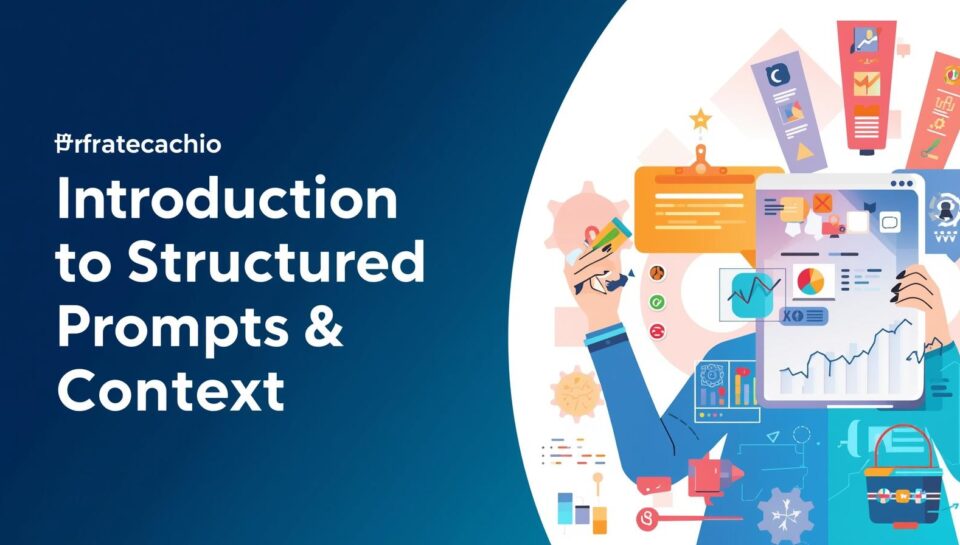
Introduction to Structured Prompts & Context
Overview
In this lesson, you will learn:
- What structured prompts are and why they matter
- How to provide context to AI for better responses
- Simple strategies for organizing information in your prompts
- Beginner-friendly ways to make prompts clear, complete, and effective
By the end, you will know how to write prompts that guide AI more precisely and produce consistent, useful outputs.
💡 Key Concepts
- Structured Prompt: A prompt organized in a way that clearly communicates task, context, and instructions to AI.
- Context: Background information or examples included in the prompt to help AI understand the task better.
- Prompt Sections: Breaking prompts into parts such as instruction, role, context, and examples.
- Consistency: Well-structured prompts reduce errors and improve clarity.
🧠 Concept Explanation
1. Why Structure Matters
AI works best when it clearly understands:
- What task to perform (instruction)
- Who is performing it (role)
- What information to consider (context)
- How to do it (format, examples, style)
Without structure, AI may misinterpret the task or produce inconsistent outputs.
Example:
- Unstructured Prompt: “Summarize this article.” → Short, vague, or inconsistent result
- Structured Prompt:
Role: You are an expert teacher. Task: Summarize the following article in 3 sentences for beginners. Context: [Insert article text] Format: Numbered list of main points.→ Clear, useful, and beginner-friendly summary
2. Adding Context
Context provides AI with background information so it can generate more relevant outputs.
Forms of context include:
- Text passages
- Examples of desired output
- User instructions (e.g., tone, style, length)
- Prior conversation history
Example:
Task: Translate English to Spanish.
Context: Use formal Spanish suitable for a business email.
Sentence: "Thank you for your prompt response."
Output: "Gracias por su pronta respuesta."
3. Prompt Sections for Beginners
A beginner-friendly structured prompt can include:
- Role/Persona: Assign a role to guide tone and perspective.
- Instruction/Task: Clearly state what AI should do.
- Context: Include background information or examples.
- Format/Output Style: Specify how AI should present results.
Example Prompt Template:
Role: You are a friendly science teacher.
Task: Explain the topic to a 10-year-old.
Context: Photosynthesis process in plants.
Format: Simple bullet points with 3 main steps.
4. Beginner Tips
- Keep sections short and clear; don’t overwhelm AI with too much text.
- Always include the role or perspective to guide tone.
- Use examples if possible (few-shot style).
- Experiment: small changes in context or structure can significantly improve output.
🧩 Practical Beginner Examples
- Structured Summary
Role: You are a history teacher.
Task: Summarize the causes of World War I.
Context: [Insert paragraph about the causes]
Format: 3 bullet points suitable for high school students.
- Structured Translation
Role: You are a professional translator.
Task: Translate English to French.
Context: Business email tone.
Text: "Please review the attached document and provide your feedback."
- Structured Advice
Role: You are a career coach.
Task: Give 3 tips to improve productivity for a college student.
Format: Numbered list with brief explanations.
⚙️ Beginner Tools
- ChatGPT / OpenAI Playground: Add structured sections in the input box.
- Google Gemini / Bard: Use role, instruction, and context fields if available.
- Notepad or Word: Draft prompts with structure before pasting into AI.
🧭 Step-by-Step Beginner Activity
- Choose a topic (e.g., “The water cycle”).
- Write a role section: “You are a friendly science teacher.”
- Write a task section: “Explain the water cycle to a 10-year-old.”
- Add context: short paragraph describing water processes.
- Specify format: 3 bullet points.
- Input prompt into AI and observe the output.
- Adjust context or format and see how responses improve.
📝 Exercises
- Write a structured prompt to summarize a news article in 3 simple sentences.
- Create a structured prompt to translate a sentence with a formal tone.
- Design a structured prompt to give advice on healthy habits.
- Experiment by changing the role or context and compare outputs.
🔍 Summary & Key Takeaways
- Structured prompts help AI understand tasks clearly.
- Breaking prompts into role, task, context, and format improves output quality.
- Context provides background for more accurate and relevant responses.
- Experimentation is key: small changes in structure or wording can make AI more effective.
- Structured prompts are a foundation for more advanced prompt engineering.













